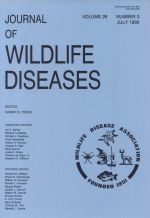Two groups of six, non-brucellosis vaccinated, brucellosis seronegative pregnant American bison (Bison bison) were individually challenged with 1 × 107 colony forming units (CFU) of Brucella abortus strain 2308. Three days after challenge, each bison group was placed in a common paddock with six non-vaccinated, brucellosis susceptible, pregnant domestic heifers. In a parallel study, two groups of six susceptible, pregnant cattle were simultaneously challenged with the identical dose as the bison and each group was placed with six susceptible cattle in order to compare bison to cattle transmission to that observed in cattle to cattle transmission. Blood samples were collected from bison and cattle weekly for at least 1 mo prior to exposure to B. abortus and for 180 days post-exposure (PE). Sera from the bison and cattle were evaluated by the Card, rivanol precipitation, standard plate agglutination, standard tube agglutination, cold complement fixation tube, warm complement fixation tube, buffered acidified plate antigen, rapid screening, bovine conjugated enzyme linked immunosorbent assay, bison or bovine conjugated enzyme linked immunosorbent assay, and the hemolysis-in-gel techniques for the presence of antibodies to Brucella spp. At the termination of pregnancy by abortion or birth of a live-calf, quarter milk samples, vaginal swabs, and placenta were collected from the dam. Rectal swabs were collected from live calves, and mediastinal lymph nodes, abomasal contents and lung were taken at necropsy from aborted fetuses for culture of Brucella spp. These tissues and swabs were cultured on restrictive media for the isolation and identification of Brucella spp. Pathogenesis of brucellosis in bison was studied in an additional group of six pregnant bison which were challenged with 1 × 107 CFU of B. abortus strain 2308. One animal was euthanatized each week PE. Tissues were collected at necropsy and later examined bacteriologically and histologically. Lesions of brucellosis in bison did not significantly differ grossly or histologically from those in cattle. There were six abortions and two nonviable calves in the bison group, as compared to nine abortions in the 12 similarly inoculated cattle. As determined by bacterial isolations, transmission of B. abortus from bison to cattle (five of 12 susceptible cattle became infected) did not differ statistically from cattle to cattle transmission (six of 12 susceptible cattle became infected) under identical conditions. No single serologic test was consistently reliable in diagnosing B. abortus infected bison for 8 wk PE. Multiple testing periods in which the Card test was used in combination with the bison conjugated enzyme linked immunosorbent assay and the hemolysis-in-gel proved to be a useful battery of serologic techniques to diagnose brucellosis in bison after the initial 8 wk PE.
How to translate text using browser tools
1 July 1990
BRUCELLA ABORTUS IN CAPTIVE BISON. I. SEROLOGY, BACTERIOLOGY, PATHOGENESIS, AND TRANSMISSION TO CATTLE
Donald S. Davis,
Joe W. Templeton,
Thomas A. Ficht,
John D. Williams,
John D. Kopec,
L. Garry Adams

Journal of Wildlife Diseases
Vol. 26 • No. 3
July 1990
Vol. 26 • No. 3
July 1990
bison
Bison bison
Brucella abortus
brucellosis
experimental study
interspecific transmission
pathogenicity




